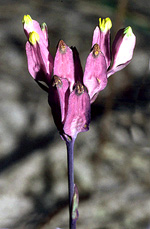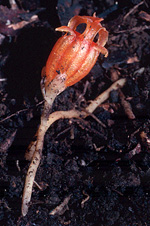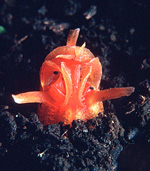 |
This small family is primarily pantropical, although a few are found in temperate regions. Two genera, Burmannia and Thismia, occur in Australia. Thismia is rarely seen, with one species in wet forests from Tasmania to south-east Queensland and one species on Cape York. Burmannia occurs in tropical and subtropical sandy swamps from New South Wales around the north to the Kimberley region.
Characteristic features of the family Burmanniaceae in Australia include: - plants partially or totally parasitic on mycorrhizal fungi
- leaves often absent (present in some species and then linear, forming a basal rosette)
- flowers solitary or clustered at or below ground level (Thismia) or in terminal racemes or spikes on scapes (Burmannia)
- perianth tubular, white, blue, yellow or red, actinomorphic
- anthers inserted on the tube, associated with irregularly lobed appendages
- ovary inferior, developing into a capsule or irregularly splitting fleshy fruit
Description
Annual or perennial terrestrial herbs perennating by rhizomes or tubers. Vegetative reproduction by rhizomes or tubers. Plants sometimes lacking recognisable stems, or leaves reduced to scales. Chlorophyll present or mostly absent, the plant then whitish, yellowish or brownish. Internal secretions not obvious. Plants glabrous or sometimes sparsely glandular-hairy. Leaves alternate and spiral, or distichous, cauline or all or mostly basal, sessile. Stipule-like lobes absent. Lamina simple, symmetric, filiform, acicular, subulate, linear, lanceolate or ovate; margins entire; base truncate, ±flat; venation parallel, with the midrib conspicuous or inconspicuous, the tertiary venation not reticulate; surfaces not punctate; herbaceous, membranous or papery. Leaf ligule absent. Plants with all the flowers bisexual. Inflorescences terminal, consisting of racemes, monochasial cymes or solitary flowers. Bracts and bracteoles absent. Pollination by insects. Flowers odourless; stalked. Floral disc present; nectaries present on the carpels. Perianth regular, of 1 whorl only, or 2 dissimilar or similar whorls, with 3 or 6, fused, petaloid segments, valvate in bud, bell-shaped or tubular, white, red, pink or blue, without contrasting markings, membranous. Fertile stamens 3 or 6, alternating with, or both opposite to and alternating with, the outer perianth lobes, at least partly fused to the perianth segments, free of the ovary and style, distinct from each other or fused by their anthers, all ±equal. Staminal filaments present or apparently absent. Anthers dorsifixed or basifixed, not versatile, opening inwards by longitudinal slits; 2-celled; with apical or lateral appendages. Ovary inferior. Carpels 3, fused; ovary with 1 or 3 locules. Style terminal, single and unbranched, or single and branched above. Ovules numerous per locule, sessile; placentation parietal or axile. Fruit a dry or somewhat fleshy capsule with irregular or circumscissile dehiscence. Disseminule micro-surface ±smooth, brown or grey, dull. Seeds numerous per fruit. Aril absent. Cotyledons 1. Embryo round or shapeless.
(Note: this description has been generated from the coded data compiled for the key. Any errors in the key data will be reflected in the descriptions.)
A treatment of the family Burmanniaceae has not yet been published in the Flora of Australia. It will appear in Volume 47.
Australian genera of Burmanniaceae (as recognised for the Flora of Australia)
Burmannia
Thismia

|
  |

Burmannia disticha (flower)
Photo: J.Eichler © J.Eichler

Thismia rodwayi (excavated plant)
Photo: J.Eichler © J.Eichler

Thismia rodwayi (flower
in situ)©

Thismia yorkensis (flowering plant)
Photo: D.Jones © D.Jones
|

| |